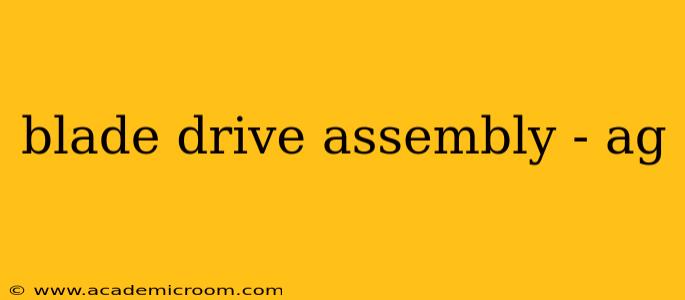The blade drive assembly is a critical component in various agricultural machines, impacting efficiency and performance significantly. Understanding its function, maintenance, and potential issues is crucial for farmers and agricultural mechanics. This comprehensive guide explores the intricacies of blade drive assemblies in agricultural settings, addressing common questions and concerns.
What is a Blade Drive Assembly in Agricultural Machinery?
A blade drive assembly is the system responsible for transmitting power from the tractor's power takeoff (PTO) or engine to the rotating blades of implements like mowers, shredders, and silage harvesters. It typically includes a gearbox, shafts, universal joints (U-joints), belts, and chains to transfer torque and adjust rotational speed. The specific design varies based on the implement's application and power requirements. For instance, a small rotary mower might have a simpler belt-driven system, whereas a large forage harvester will incorporate a complex gearbox and heavy-duty shafts. The overall goal remains consistent: reliably and efficiently powering the cutting blades.
What are the different types of blade drive assemblies used in agriculture?
Several types of blade drive assemblies exist, each suited to different applications and power levels:
-
Belt-driven systems: These are common in lighter-duty implements like smaller mowers and rotary tillers. They're relatively simple, inexpensive, and easy to maintain, but offer less torque and are susceptible to slippage under heavy loads.
-
Gear-driven systems: These systems, using gears and shafts, offer superior torque transmission and are favored in heavier-duty implements such as larger mowers, shredders, and forage harvesters. They're more robust but also more complex and expensive.
-
Hydraulic drive systems: These systems use hydraulic motors to power the blades, offering precise speed control and the ability to handle varying loads efficiently. They are commonly found in high-capacity equipment where variable speed is advantageous.
-
Chain-driven systems: Often found in conjunction with other drive systems, chains provide a robust and durable method of transferring power, particularly in applications requiring high torque and reliability.
The choice of drive system depends on factors like the size and type of implement, the power source, required cutting speed, and budget considerations.
How does a blade drive assembly work?
The functioning of a blade drive assembly depends on its type, but the general principle is the same: to efficiently transfer power to the cutting blades. Let's take a belt-driven system as an example. Power from the PTO is transferred to a pulley, which in turn drives a belt connected to another pulley on the blade shaft. The belt's rotational speed determines the blades' cutting speed. Gear-driven systems employ a similar principle but use gears and shafts for more efficient and robust power transmission. Hydraulic systems utilize the hydraulic flow to drive a hydraulic motor, connected to the blades, thus providing a smooth and adjustable power transfer.
How do I maintain a blade drive assembly?
Regular maintenance is essential to prevent breakdowns and ensure optimal performance. This includes:
-
Regular inspection: Check for wear and tear on belts, chains, gears, and shafts. Look for cracks, fraying, excessive wear, and misalignment.
-
Lubrication: Proper lubrication is critical, especially for gear-driven systems. Follow the manufacturer's recommendations for lubrication intervals and types of grease or oil.
-
Belt tension: Ensure belts are properly tensioned to avoid slippage and premature wear.
-
Component replacement: Replace worn or damaged components promptly to prevent further damage and ensure safety.
-
Cleaning: Keep the assembly clean and free of debris to prevent damage and improve performance.
What are common problems with blade drive assemblies?
Common problems include:
-
Belt slippage: This often indicates worn belts or incorrect tension.
-
Broken belts or chains: Caused by excessive wear, overloading, or improper maintenance.
-
Gear wear or damage: Resulting from overloading, lack of lubrication, or impact damage.
-
Shaft misalignment: Leading to increased wear and potential failure.
-
Bearing failure: Caused by lack of lubrication or excessive wear.
Addressing these issues promptly will prevent costly repairs and ensure the efficient operation of your agricultural machinery. Regular maintenance and careful operation are key to the longevity and performance of your blade drive assembly.
